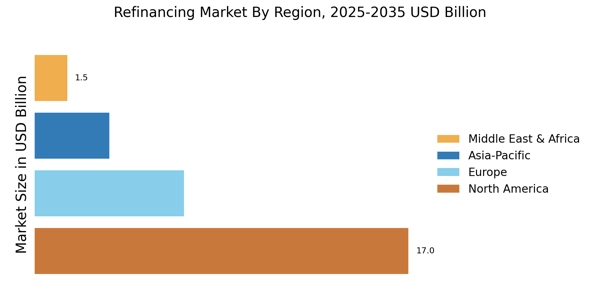Regulatory Changes
The Refinancing Market is subject to various regulatory changes that can impact refinancing activities. Recent legislative measures aimed at consumer protection and financial stability have introduced new guidelines for lenders, affecting how refinancing transactions are conducted. For instance, regulations surrounding disclosure requirements and loan origination practices have become more stringent, ensuring that borrowers are well-informed about their options. These changes may initially create challenges for lenders, as they adapt to new compliance standards. However, they also serve to enhance consumer confidence in the refinancing process, as borrowers feel more secure in their decisions. As the industry navigates these regulatory shifts, it is likely that refinancing trends will evolve, with an emphasis on transparency and borrower education, ultimately shaping the future landscape of the Refinancing Market.
Increased Home Equity
The Refinancing Market is experiencing a notable increase in home equity, which serves as a significant driver for refinancing activities. As property values appreciate, homeowners find themselves with greater equity in their homes, allowing them to leverage this asset for refinancing purposes. Recent data suggests that the average homeowner has seen a 10% increase in home equity over the past year, providing a compelling incentive to refinance. This trend enables borrowers to access cash for various needs, such as home improvements or debt consolidation, while potentially securing lower interest rates. The ability to tap into home equity not only enhances financial flexibility but also stimulates refinancing demand, as homeowners recognize the potential benefits of utilizing their increased equity to improve their overall financial health.
Rising Interest Rates
The Refinancing Market is currently influenced by the trend of rising interest rates. As central banks adjust their monetary policies, the cost of borrowing increases, prompting homeowners to consider refinancing their existing loans to secure lower rates before they rise further. In recent months, the average interest rate for a 30-year fixed mortgage has shown an upward trajectory, reaching approximately 4.5%. This environment creates a sense of urgency among borrowers, as they seek to capitalize on favorable terms before potential hikes. Consequently, lenders are witnessing an uptick in refinancing applications, as consumers aim to reduce their monthly payments or consolidate debt. This driver indicates a dynamic shift in consumer behavior, as individuals actively seek to optimize their financial positions in response to changing economic conditions.
Technological Advancements
The Refinancing Market is increasingly shaped by technological advancements that streamline the refinancing process. Innovations such as online applications, automated underwriting, and digital document management have transformed how lenders and borrowers interact. Recent surveys indicate that over 60% of consumers prefer to initiate their refinancing applications online, reflecting a shift towards digital solutions. This trend not only enhances convenience for borrowers but also reduces processing times for lenders, allowing for quicker approvals and disbursements. As technology continues to evolve, it is anticipated that the Refinancing Market will witness further enhancements in efficiency and customer experience. The integration of artificial intelligence and machine learning may also play a role in personalizing refinancing offers, tailoring them to individual borrower profiles, thereby fostering a more responsive and customer-centric market.
Competitive Lending Environment
The Refinancing Market is characterized by a highly competitive lending environment, which significantly influences refinancing decisions. Lenders are actively vying for market share, leading to attractive offers and incentives for borrowers. Recent statistics indicate that the number of lenders in the refinancing space has increased by 15% over the last year, resulting in a wider array of options for consumers. This competition drives down interest rates and origination fees, making refinancing more appealing to homeowners. As borrowers become more discerning, they are likely to shop around for the best deals, further intensifying competition among lenders. This dynamic not only benefits consumers through lower costs but also encourages innovation in loan products, ultimately shaping the Refinancing Market in a manner that prioritizes borrower needs and preferences.


















Leave a Comment